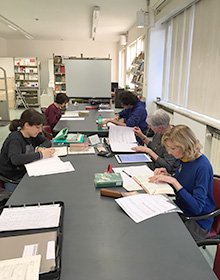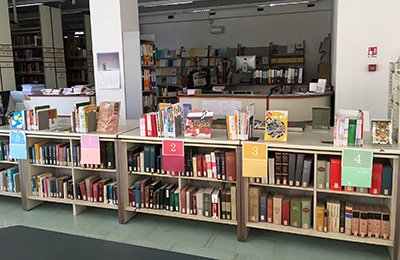2019 Japanese-Language Assistants’ Report: Helping Students Enjoy Learning Japanese
The Japan Cultural Institute in Rome
SAITO Taki
The Japan Cultural Institute in Rome (hereafter referred to as "the Institute") is located in the Parioli district, a quiet residential area in the northern part of Borghese Park, a place of relaxation for the citizens of Rome. The following is an introduction to the work of a Japanese-Language Assistant (hereafter referred to as "Assistant") at the Institute, where about 250 learners, from those in their teens to those in their 80s, and with various purposes, are studying Japanese.
The Work of Assistants in Japanese-Language Courses
As of the 2018-2019 academic year (October 2018-May 2019), we have the following four courses: Comprehensive (3 hours x twice a week), Evening (2 hours x twice a week), Saturday (2 hours x once a week), and Autonomous Learning Support (2 hours x once a week). In the Comprehensive, Evening, and Saturday courses, all classes use "Marugoto: Japanese Language and Culture" (the official course book of the Japan Foundation , which complies to the JF Standard for Japanese-Language Education), and classes are conducted in a task-oriented manner that emphasizes what students can do in Japanese. This year, the Assistant is in charge of four hours per week of the Evening course and two hours per week of the Autonomous Learning Support course. The Assistant is also involved in the overall operation of the Japanese-language courses. Specifically, this includes taking registrations for courses twice a year, assisting in responding to e-mail inquiries from students and the general public, publicizing courses, contacting instructors, and planning and organizing Japanese-related events. As of this year, registration for the starter class, who are studying Japanese for the first time, is not on a first-come, first-served basis but through a screening process, so I was also involved in the translation of application documents from Italian into Japanese. Through my translation work, I was able to encounter a variety of motivations for learning and a strong desire to learn, which was a very valuable experience for me as a teacher of Japanese.
Portfolio Competition
As an event of the whole course, I especially focused on the portfolio competition. This competition is mainly run by Assistants. The portfolio consists of (1) a "Can-do" checklist (at the end of each class, students write comments on their can-do achievements and things they have noticed, etc.), (2) learning deliverables, and (3) a record of cross-cultural experiences, and is to provide students with a chance to record for themselves what they have learned. To encourage the creation of the portfolios and to provide a forum for students to showcase their learning, a competition was launched in the second term of the 2016-2017 academic year, and is held twice a year at the end of the term. The portfolios of the representatives selected from each class will be exhibited, and the best prize will be awarded from each of the Comprehensive, Evening, and Saturday courses. This year, the third year of the program, the instructors reported that even among those who unfortunately were not chosen as class representatives, there were wonderful portfolios by students who were very enthusiastic and enjoyed their self study. Therefore, apart from the competition, we have created an opportunity to exhibit such works. I think this is evidence that self study through portfolio creation is becoming more widespread. I would like to continue to think of ways to encourage learners to actively create portfolios in the future.
Autonomous Learning Support Course — Lifelong Learning and Exchange through Japanese Language

The Autonomous Learning Support course
In this course, which is taught by an Assistant, learners think about what they want to be able to do in Japanese (can-do), and proceed with their studies at their own pace, according to the goals and study methods they have set. This course was launched in the 2017-2018 academic year with the aim of supporting learners who, for various reasons, cannot attend classes or do not have a class level that suits them, and also to promote self study outside of class. The teacher's role is to advise the learner when they are lost or ask for help in the course of study. Some of the students have been studying Japanese for a long time, and some of them are elderly people who are studying Japanese as a lifelong learning experience. They are actively working toward their own goals, such as creating a booklet on the origins of Kanji characters and writing a joint report on modern Japanese writers. At first, I was at a loss as to how to support the learners, but as I talked with each learner and corrected their work, I was able to gain a deeper understanding of what they were struggling with and what they wanted to achieve. Also, as aids to help learners to study on their own, I took the time to introduce online learning materials and books, and to explain how to use Japanese dictionaries and textbooks. Then, the learners began to voluntarily exchange information and become interested in each other's learning content. As a teacher, I was very happy to see this.
On the other hand, however, there is also the issue that many participants fail to understand the purpose of the course or feel that autonomous learning is too much of a hurdle, and so they drop out of the course. In the future, I would like to deepen my own knowledge of online learning materials, etc., and be able to provide useful information in order to create opportunities for starter level and first-time learners who register for this course to study by themselves without giving up. In my second year as an Assistant, I would like to continue my efforts to make this course a place where learners of all ages and occupations can enjoy interacting with each other through their common interest in the Japanese language.
Japanese Extensive Reading Club
In order to provide opportunities for learners to come into contact with Japanese books other than the textbooks covered in the classes and to encourage the use of the library, the Japanese-language courses hold a monthly "Japanese Extensive Reading Club" (hereafter referred to as "Extensive Reading Club") in the library of the Institute. Extensive reading is a method of improving Japanese language skills by reading a lot, starting with simple things, guessing the meanings of words from illustrations and scenes, without using a dictionary. The Extensive Reading Club is a reading group that uses this method to read Japanese books. The Assistant works with the librarian to plan, organize, and publicize the club. On the day of the meeting, the librarian prepares the books (various levels of reading materials, picture books, simple novels, etc.) and gives a 30-minute lecture in Italian for first time participants with the Assistant. In this lecture, the Assistant explains the method of extensive reading and its effects, and then the librarian demonstrates the method by showing actual books. This year, we publicized the event by placing flyers at universities to encourage general learners to participate, which resulted in an increase in the number of repeat participants and active interaction with learners in the Institute during the discussion time. In the next year, we would like to put more effort into publicity to let more people know about this club and to let them experience the feeling that they can enjoy reading in Japanese even at the starter level.

Extensive Reading Club. The books are divided into five different levels.
- What We Do Top
- Arts and Cultural Exchange [Culture]
- Japanese-Language Education Overseas [Language]
- Japanese-Language Education Overseas [Language] Top
- Learn Japanese-language
- Teach Japanese-language
- Take Japanese-Language Test
- Know about Japanese-language education abroad
- The Japanese-Language Institute, Urawa
- The Japanese-Language Institute, Kansai
- Japanese-Language Programs for Foreign Specified Skilled Worker Candidates
- Japanese Language Education for Japanese Children Resident Overseas and for the Descendants of Migrants
- Archives
- Japanese Studies and Global Partnerships [Dialogue]
- JF digital collection
- Other Programs / Programs to Commemorate Exchange Year
- Awards and Prizes
- Publications
